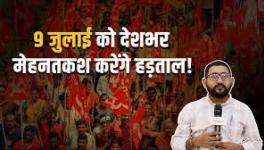The CAG Report: Raja has no clothes
The CAG final report which is circulating in the media has substantiated all the charges that Sitaram Yechury had made in his letter to PM in May 10,2010. The dimension of the scam for 2nd generation (2G) licenses as per CAG's calculations is a mammoth Rs. 1,76,000 crore. It has also brought out some new issues that were not known before. Out of the 122 new licenses awarded, 85 were to parties who did not qualify as per DoT's own criteria on eligibility. The other fact that has been brought out is that the issue of legality of awarding licenses was referred to Ministry of Law by the Ministry of Communications and IT, who disagreed with the procedure proposed to be adopted. The Department of Telecommunication (DoT) still went ahead with their course of action in violation of Transaction of Business Rules of the Government, which demands that any difference between ministries be resolved at the Cabinet level or though an Empowered Group of Ministers.
The loss to the exchequer of Rs. 1,76,000 crore is of the order of 2% of our GDP and roughly 1/3 of our current tax revenue. If this money had been available to the exchequer instead of being gifted to the Unitechs and Swans, imagine what we could have done with this money. To to put it in perspective, this is 8 times the centre's total health budget and three and a half times the education budget. Imagine how many schools and colleges could have been opened, how many power plants could have been set up, the new roads and rail links we could have built. Instead, a corrupt leadership has connived with a bunch of real estate operators to fleece the nation of another scarce national resource – the wireless spectrum.
The current UPA Government is presiding over the biggest loot of our national resources we have ever seen. The mining interests, the real estate operators and carpetbaggers such as those involved in the Commonwealth Games, are expanding Indian capitalism through private loot of public resources. This is primitive accumulation of capital on a grand scale. It is this speculative capital that is running the country today.
Sitaram's letter had identified three elements in the telecom scam. One was of course giving away 122 licenses at 2001 prices in 2008. In 2001, there were barely 4 million mobile subscribers as against 300 million subscribers in 2008. With this expansion of the telecom market, using 2001 prices in 2008 was nothing but providing largesses to friends and relations. While the media focussed on this aspect of the scam, there were also two other components. One was the conversion of CDMA licenses to Unified Access Services (UAS), by virtue of which Reliance and Tata entered the GSM based mobile services. The third was the extra spectrum that the existing operators had hogged beyond their originally sanctioned amount. The table below summarises the amounts computed by the CPI(M) as in the letter to PM by Sitaram Yechury and the computations by CAG.
|
These figures are now longer conjectures of experts or figures computed by people who could be accused of being critical of the Government. These are figures worked out by a bunch of government auditors who had access to the files of the Department of Telecom and have come to their independent conclusions.
Who were the major beneficiaries of the scam? As the CAG Report makes clear, not only were the new licenses for 2G undervalued, but certain parties picked out for special favours. Swan and Unitech, the two real estate companies, were particular favourites. The second set of beneficiaries were the CDMA license holders -- Reliance and Tata -- who were given cross-over licenses for the bigger GSM market. The third were those GSM operators – Vodafone and Bharati in particular -- who were holding spectrum well-beyond their original allotted spectrum.
The CAG report has also substantiated the charges made in the letter that Sitaram Yechury had written regarding violations of TRAI recommendations and disregarding the advise of other Ministries. The Report states, “The entire process of spectrum allocation was undertaken in an arbitrary manner. The Hon’ble Prime Minister had stressed on the need for a fair and transparent allocation of spectrum, and the Ministry of Finance, and the Ministry of Law and Justice had sought for the decision regarding spectrum pricing to be considered by an EGoM. Brushing aside these concerns and advices, the Department of Telecommunications, in 2008, proceeded to issue 122 new licences for 2G spectrum at 2001 prices, thus flouting all rules and procedures to be followed in a parliamentary democratic set up. The process followed for spectrum allocation was also unfair, considering the fact that DoT did not follow its own guidelines on eligibility conditions, arbitrarily changed the cut off date for receipt of applications post facto and altered the conditions of the FCFS (first-come first-served) procedure it had been following, gave unfair advantage of certain companies over others thus creating an environment which can not be perceived as transparent and fair.”
As the CAG Report makes clear, the manipulations to the stated first-come first-served policies were done to benefit certain parties. It again substantiates what Yechury had brought out in his May letter to the PM. The original first-come first-served had the application date as defining who are first-come. On Jan 10, 2010 this was changed to who fulfils LOI conditions first amongst the parties selected. CAG states, “Thus DoT deviated from its declared FCFS (first-cum-first-served) policy though MOCIT (Minister of Communications & IT) maintained that it was continuing ‘with the policy for processing of applications’.”
Further, the parties were given only a few hours to fulfil the conditions of the LOI instead of 15 days originally stated. CAG brings out, “It was noticed that 13 applicants were even ready with Demand Drafts (added: Bank draft amounts were of the order of Rs. 1651 crore) drawn on dates prior to the notification of cut off date and some had even managed securing Bank Guarantees. Evidently, these applicants, had advance information about the issue of this notification by DoT which enabled them to take appropriate advance action to draw the DDs and prepare other relevant documents for complying with the LoI conditions in spite of the changed time limit for compliance from 15 days to about half a day”.
Again the CAG notes, “The entire process of putting a cut off date, and then deciding to change it after receiving applications created an artificial demand and competition for obtaining licences in the telecom sector. The subsequent events of informing applicants regarding change in FCFS criteria and simultaneously asking them to collect LoIs from DoT in response to their UAS applications, a large number of applicants complying with detailed requirements of LoI (for which 15 days are allowed as per procedure) within hours ; all reflect a deliberate and unhealthy haste on part of DoT in going ahead with the issue of licences which tended to favour applicants who could proactively anticipate such procedural changes well in time.”
The new story that emerges from the CAG report is that DoT violated its own Policy Guidelines on eligibility of parties in awarding licenses. The CAG makes clear that most of the parties did not meet the pre-conditions for licenses – their main objectives in the Memorandum of Association and paid up capital were not in conformity with DoT's eligibility criteria. The Report states,“Verification of the files of the DoT and public documents accessed from the Ministry of Corporate Affairs, Government of India, New Delhi, revealed that as many as 85 Licenses to 12 Companies, out of the 122 new licenses issued in January 2008 were granted to those which did not satisfy the eligibility conditions prescribed by DoT. While 72 licenses were given to companies which did not have the stipulated paid up capital at the time of application, 27 licenses were issued to companies who failed to satisfy conditions of main object clause in their Memorandum of Association and the share holding pattern declared by one Company did not meet DoT stipulations.”
Further, Reliance had holdings of more than 10% in Swan, and according to DoT's eligibility criteria should have been disqualified. Not only were they given licenses, in two major circles, eligible bidders were disqualified to allow Swan to secure licenses in these circles.
The picture that emerges from the CAG report is an ugly one. It is a systematic violation of law and procedures at many levels, all for giving away spectrum at a fraction of its market value to favoured parties. The beneficiaries have been identified time and again. Some of them were know to be close to the Minister and the then Secretary, Ministry of Communications and IT, during their Environmental Ministry days.
The question that troubles all of us is why is it that even after multiple agencies of the Government have identified the nature and the dimension of the scam, the Minister continues to be protected. He himself is on record – this is also verified from the CAG Report – that the entire Cabinet and the PM were fully on board on the decisions he had taken. The CAG Report also brings out that the Terms of reference of the Empowered Group of Ministers had been modified to take out spectrum pricing from its scope. He not only has been shielded by the UPA Government, his nominee, PJ Thomas, who defended the 2G spectrum as Telecom Secretary, was made the Central Vigilance Commissioner. He is the man now who will verify the validity of the defence of the Minister that he made as Secretary! The Supreme Court has slammed the CBI for dragging its feet on this issue.
Are we then to take this scam as a lone operation of telecom minister and the exigencies of coalition politics? Or is it true --as Raja himself has stated on numerous occasions -- he has the support and the backing of the PM and his cabinet on whatever he has done? The Prime Minister and his cabinet must now come clean on this.
Get the latest reports & analysis with people's perspective on Protests, movements & deep analytical videos, discussions of the current affairs in your Telegram app. Subscribe to NewsClick's Telegram channel & get Real-Time updates on stories, as they get published on our website.
























